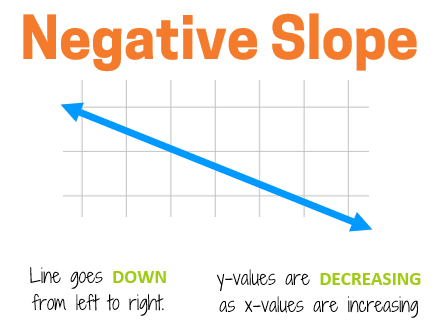
That’s how powerful and versatile the slope intercept formula is. I recommend looking through the articles below for a better understanding of how the automated design and the constraint priorities work. The paper offers a simple method of providing dispatch data which solves the problem of negative slopes and avoids significant fuel cost due to dispatch error. There are multiple settings that affect the adverse slopes that result from the design. This paper shows that certain design characteristics of generating units are responsible for negatively sloping incremental heat rate curves with negative slopes. Simply by changing the values of m and b, we can define any straight line. The negative slopes that remain after making the above changes are due to not being able to satisfy all constraints. A positive y-intercept means the line crosses the y-axis above the origin, while a negative y-intercept means that the line crosses below the origin. When m gets smaller, the slope flattens.Ĭhanging the value of b moved the line around the coordinate plane. As m, the slope, gets larger, the line gets steeper. That was fun, eh? You should have noticed that changing the value of m could swivel the line from horizontal to nearly vertical and through every slope in between.
NEGATIVE SLOPE INSTALL
Please make sure that Java 1.4.2 (or later) is installed and active in your browser ( Click here to install Java now) Sorry, the GeoGebra Applet could not be started. Try sliding each bar back and forth, and see how that affects the line. A negative slope that is larger in absolute. The bar labeled b changes the y-intercept. A higher positive slope means a steeper upward tilt to the curve, which you can see at higher output levels. Instead of going up and to the right, you will go down. The bar labeled m lets you adjust the slope, or steepness, of the line. To graph a negative slope, apply the same rise/run principle that youd apply for a positive slope. Multiply this number by 100 and you have the percentage slope.

Convert the rise and run to the same units and then divide the rise by the run.

It has two slider bars that can be manipulated. Slope can be calculated as a percentage which is calculated in much the same way as the gradient. If the object has a velocity of 0 m/s, then the slope of the line will be 0 m/s.The graph below represents any line that can be written in slope intercept form.

If the object is moving with a velocity of -8 m/s, then the slope of the line will be -8 m/s. If the object is moving with a velocity of +4 m/s, then the slope of the line will be +4 m/s. The principle is that the slope of the line on a position-time graph is equal to the velocity of the object. That is, the slope of the line is 0 m/s - the same as the velocity during this time interval.īoth of these examples reveal an important principle. During the last 5 seconds (5 to 10 seconds), the line slopes up 0 meters. Thus, the slope of the line on the graph equals the velocity of the car. 3 9 20 Devices of this type can amplify signals, 3 11 13 and are what is usually meant by the term 'negative resistance'. time graph has a slope of +5 meters/1 second for the first five seconds. Points on the curve where the slope is negative (declining to the right), meaning an increase in voltage causes a decrease in current, have negative differential resistance ( ).

For the first five seconds the line on the graph slopes up 5 meters for every 1 second along the horizontal (time) axis. If the position-time data for such a car were graphed, then the resulting graph would look like the graph at the right.


 0 kommentar(er)
0 kommentar(er)
